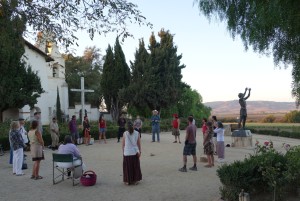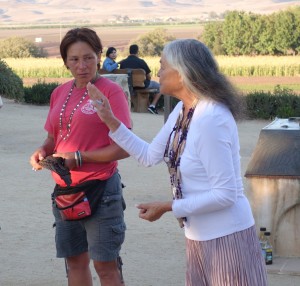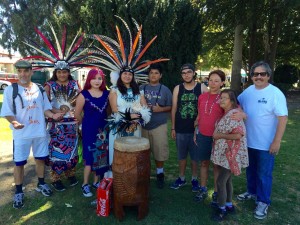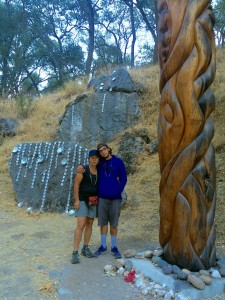Posted on September 21, 2015
Standing Vigil at Sunset in San Juan Bautista
After a long Sunday’s journey in the sweltering heat, we arrived at San Juan Bautista as the sun was preparing to set on the golden hills surrounding the valley. An eerie billboard on the edge of town reads, “Welcome to History,” depicting a pastoral scene of the Mission and a horse drawn-plough.
We were honored to be joined at the Mission by Mutsun Ohlone elder Ann Marie Sayers and a circle of community members including three young men from the Watsonville Brown Berets and three runners from Peace and Dignity Journeys. Ann Marie Sayers led a blessing and welcomed the walkers to Mutsun territory, informing us that the Mission was built upon the site of the village named Popeloutchom. She addressed the group with sharp clarity:
“When you walk in to this Mission, you do not see the name of the peoples that were here. You do not see any kind of representation of the Native peoples on whose land we are on right now. And by God, we’re still here. Thats who it is I want to respect and honor.”
Ann Marie told us that she lives nearby in a place called Indian Canyon, the only federally recognized Indian Country for 350 miles along the coast of California. “I’ve opened up my Great Grandfather’s trust allotment to all indigenous people who are in need of traditional lands for ceremony,” she explained.
She then recounted some of the history of Indian Canyon— that during Mission times, the canyon actually served as a safe haven for Native peoples who ran away from the Mission or were trying to avoid being missionized. “Conditions here [at the Mission] were not acceptable. It was absolutely horrible…People would run away to their villages, and when they were captured and brought back, an example was made of them—they were whipped, and many were killed. There are so many bones in many of the different Missions of little children that were bent over, curves in their bones, from lifting too many bricks. These are the kind of stories I want to remember, to honor the ancestors.”
A wooden sign by the Mission chapel states that about 4,300 individuals are buried in unmarked graves on the premises. According to records kept by the Missionaries, by 1850, a total of 4,434 Native Americans had been baptized at Mission San Juan Bautista, and 3,756 of them had died. In other words, the death rate at this Mission was roughly 85.8%.
On our path to San Juan Bautista, we stopped for a snack break in the Main Plaza of Watsonville. Serendipitously, we crossed paths with a group of Mexica dancers who were conducting a ceremony on the grass. After learning of our purpose, they shared kind words of support and led a special blessing for the Walk.
Leaving San Juan Bautista on Monday morning, we followed the scenic San Juan Grade road through the Gavilan Mountains. We’re doing everything we can to gather strength for Wednesday in Carmel. Louise J. Miranda Ramirez, Chairwoman of the Ohlone Costanoan Esselen Nation, accepted our request for permission to enter her territory, and has invited us to join her in prayer and mourning in the cemetery of Mission San Carlos where her ancestors are buried. It will be a difficult and painful day, as the Pope officially declares the sainthood of Serra and hundreds will be gathered at Mission Carmel to celebrate it. Click here for information about joining us in this Day of Mourning.





